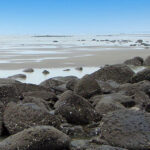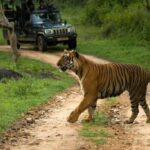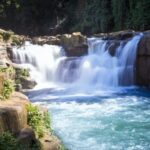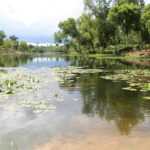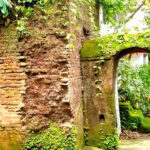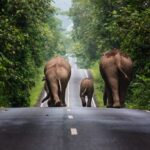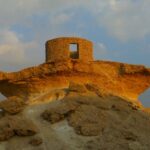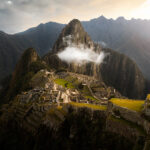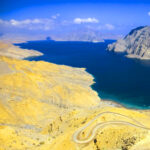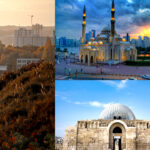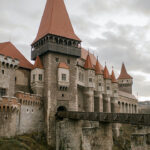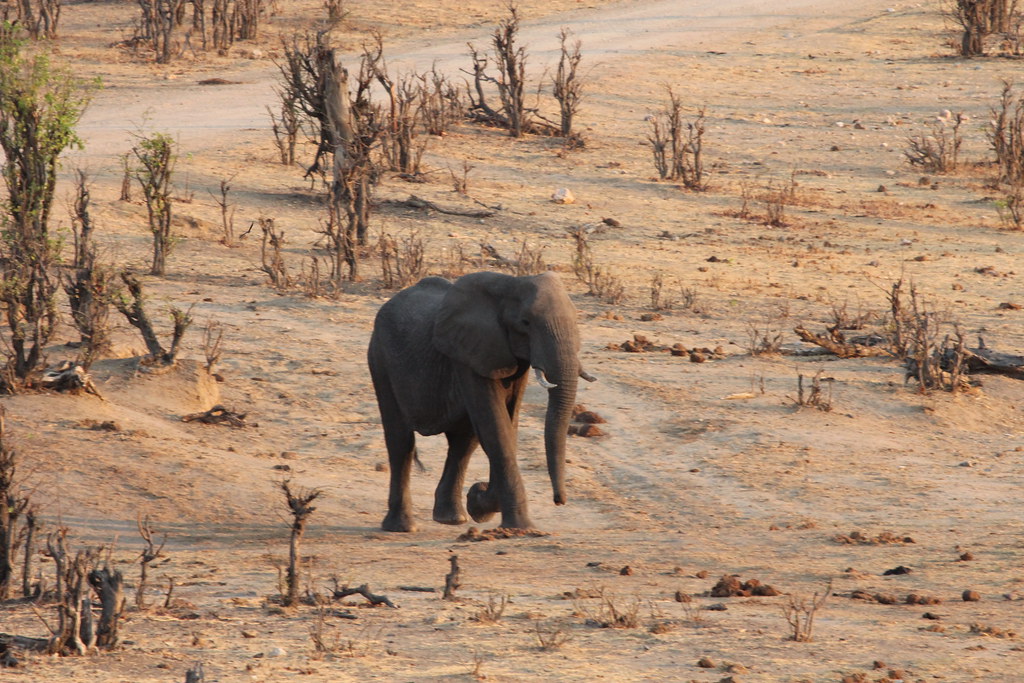
Hwange National Park is packed with big game and is famous for massive numbers of buffalo and — in particular — its elephant herds
Rusty squats down and inspects the tracks, his rifle held in the crook of one arm. “This track is fresh,” he says, pointing to two lion prints. “I am sure that the lion is somewhere nearby. Stay quiet,” he cautions. Keeping down, I glance through the trees, expecting to catch a glimpse of the big cat. Rusty gets up cautiously and searches the ground nearby. “Looks like they are near, very near,” he says.
Following our guide Rusty, we wait behind the bushes. At first sight, the area looks dead, however, upon closer look, we find some greenery, with clouds hovering over it. It was in early November and according to Rusty, the wet season starts here from November and lasts till March. Rusty leads on and again stops to inspect another lion print. He nods and says, “They were moving around. Remember the rules. Stay with the gun. Never run.”
While it’s safe to roam around in national parks in this part of the world, it is always recommended that a guide accompany you. All guides in Zimbabwe are great shots who are supremely competent in those awkward moments, like a lion charge. In Rusty’s case, I knew he had spent his life handling such tricky situations, having been born and brought up in this place: Hwange National Park.
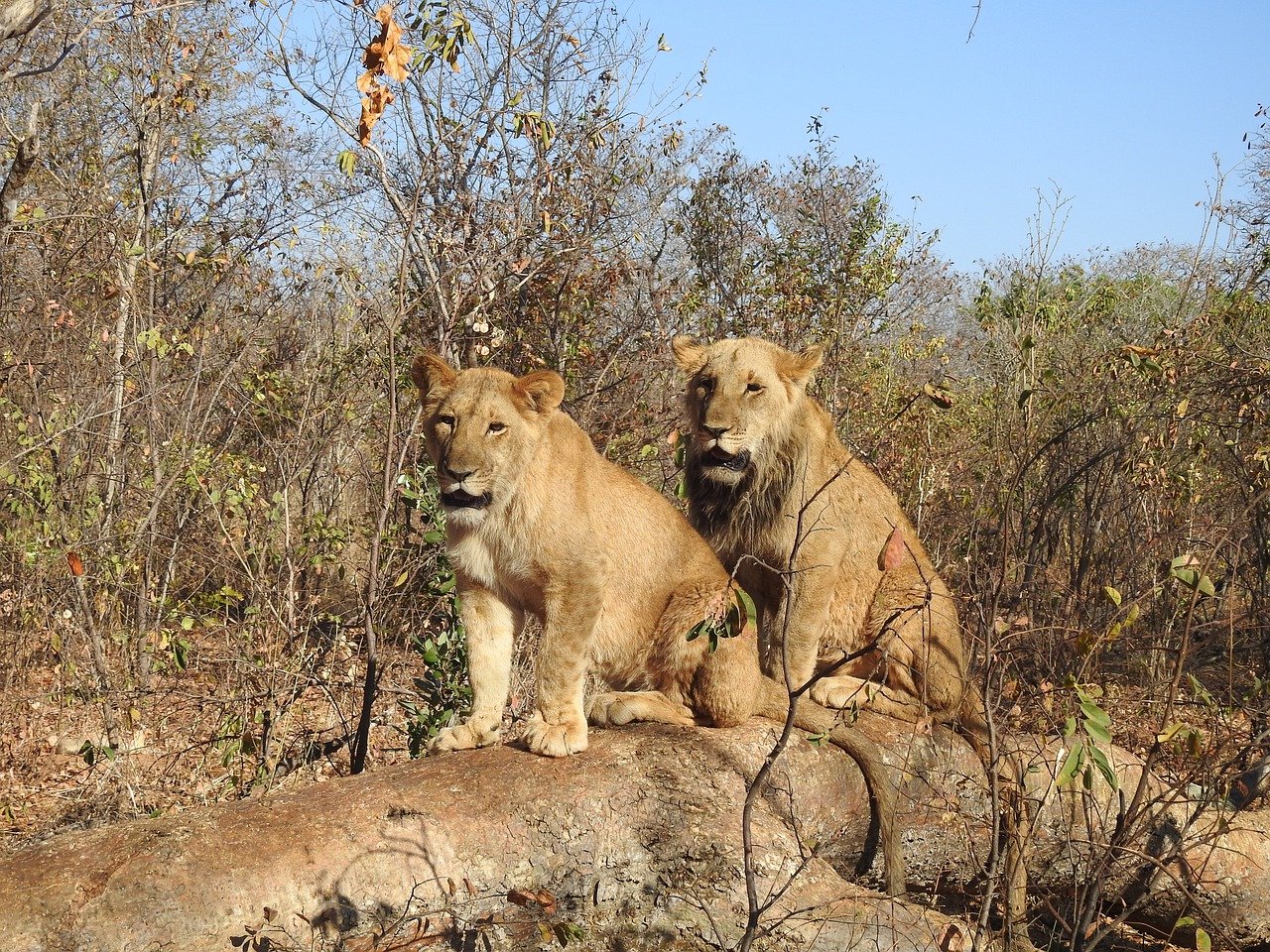
Little history
The largest and best known of Zimbabwe’s national parks, Hwange National Park is packed with big game and is famous for massive numbers of buffalo and — in particular — its elephant herds. The park boasts over 100 species of mammals and nearly 400 bird species recorded. It is said that the population of wild dogs in Hwange is one of the largest in Africa.
The park is named after the warrior king Mzilikazi of the Ndebele tribe. He used the area as a hunting ground before it was declared a national park in the 1920s. Just an hour drive from the Victoria Falls, it is one of Africa’s finest havens for wildlife and is home to a vast array of animals. Herd of animals, ranging from eland, zebra, giraffe, sable, wildebeest, roan, sable and kudu, can be easily seen roaming around the park.
Another feature that makes Hwange different from the other parks in the region are the shallow pans (lake-lets) and natural salt-licks. In the dry winter months, animals are often seen coming to these pans for drinking water. The flora of the park is mostly Acacia woodland set in Kalahari sands. And it is also the most accessible reserve in the country; hiring cars from Victoria Falls or Bulawayo is easy and cheap.
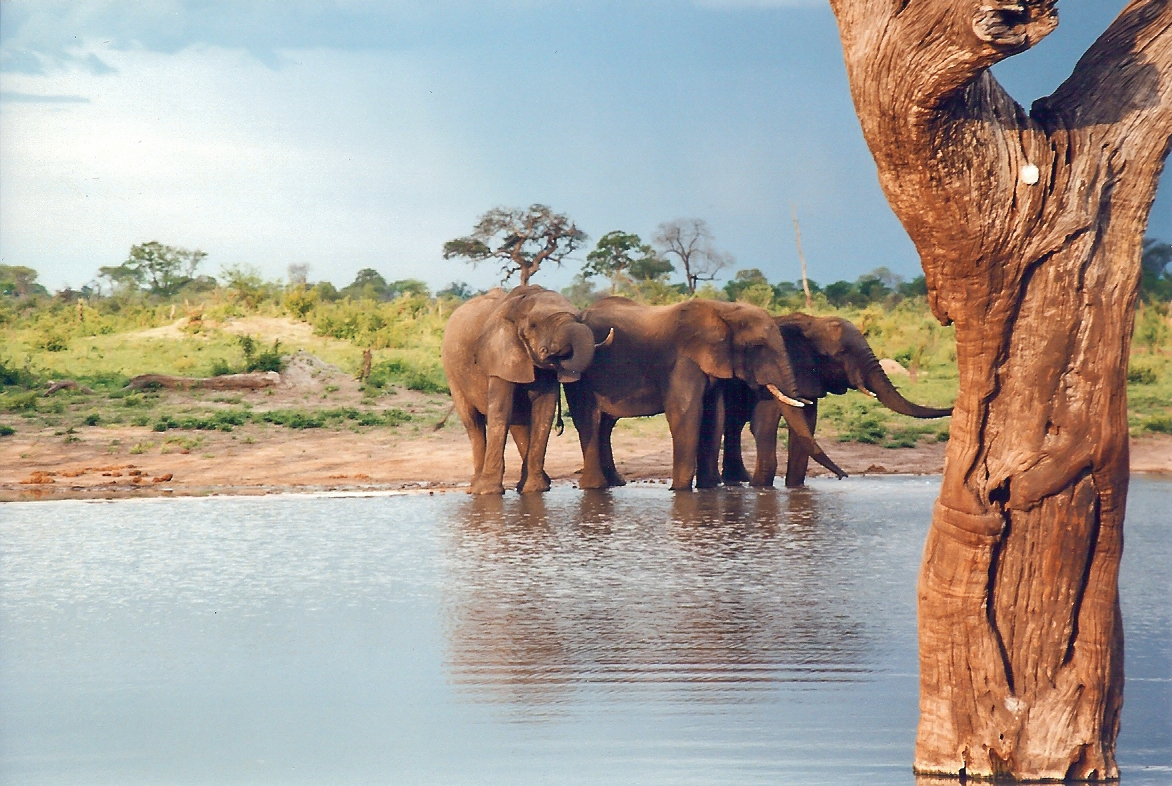
Back to sighting
So I stand there, watching Rusty moving ahead looking at the footprints of the lions. Then suddenly Rusty points his finger. “There”. Soon I saw a lioness behind the bushes. The tension was incredible. She was so close. Would she pounce? Or would she just disappear before we got the chance to see her clearly? Instead she just padded her way, into the bushes and she disappeared.
We came back to our camp as dusk was falling and arrived in time to sit around the campfire, watch the sun set, and allow the events of the day to sink in. While it may surprise many, it is true that Zimbabwe is very safe, and that its people are utterly charming.
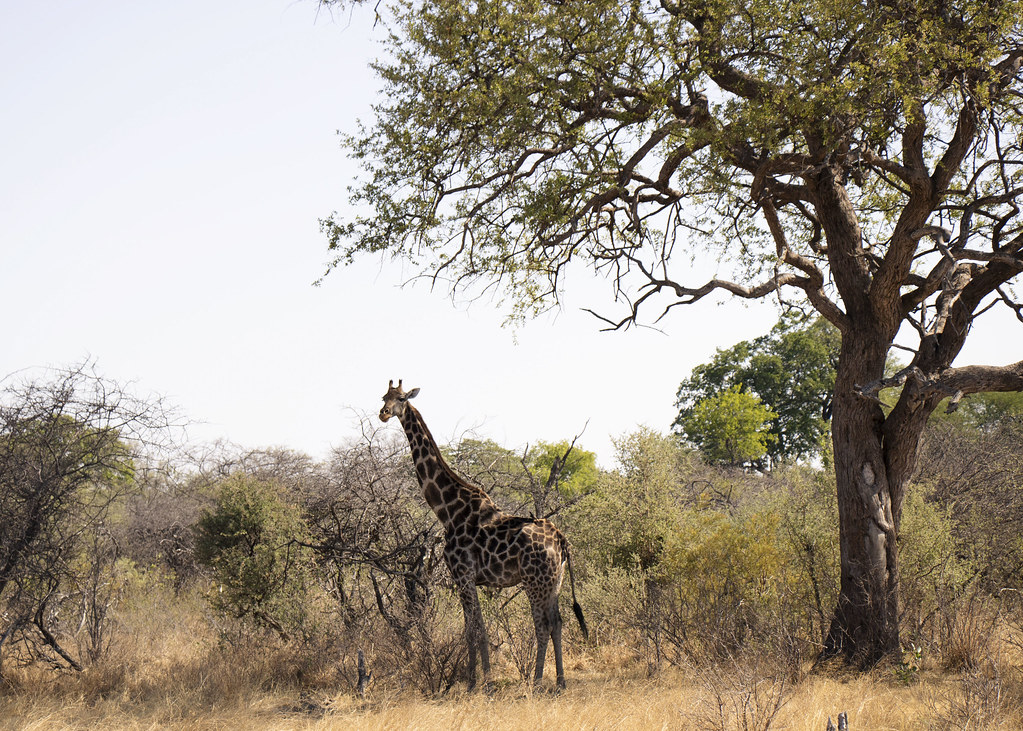
Best time
The best time to visit the Hwange is from July to August and from December to March. Game viewing is at its best in the dry season (from July-August, and the driest in September and October), when the scarcity of water attracts large numbers of elephants to the waterholes. During the rainy season (November to March), the wildlife is dispersed across the park, which make it difficult to spot them. However, you can visit during this time to watch the birdlife, it’s spectacular!
সাফারি ভ্রমণ জিম্বাবুয়ের হোয়াংগে ন্যাশলার পার্ক
হোয়াংগে ন্যাশলার পার্ক বড় বড় সব খেলার জন্য বিখ্যাত। আর এখানে পাবেন অগণিত ষাঁড়ের দেখা, বিশেষ করে আছে হাতির পাল।
রাস্টি উবু হয়ে রাস্তাটি পর্যবেক্ষণ করছে, এক কাঁধে তার বন্দুক ঝুলছে। সিংহের দুটি পায়ের ছাপের দিকে আঙুল তুলে বলল, “এই চিহ্নটা একদম তাজা”। সাবধানি হওয়ার পরামর্শ দিয়ে সে আবার বলল, “আমি নিশ্চিত সিংহগুলো আশেপাশেই আছে। একদম শান্ত থাকুন।” বনের রাজার দেখা পাওয়ার আশায় পা টিপে টিপে আমি গাছের ফাঁক গলে একটু তাকালাম। রাস্টি সাবধানতার সঙ্গে উঠে দাঁড়ায় এবং এদিক সেদিক দেখে। ফিসফিস করে বলে ওঠে, “মনে হচ্ছে তার কাছাকাছিই আছে, খুব কাছাকাছি।”
আমাদের গাইড রাস্টিকে অনুসরণ করে আমরা একটি ঝোপের পেছনে অপেক্ষা করছিলাম। প্রথম দেখাতে জায়গাটিকে রুক্ষ ও মৃত মনে হবে। তবে একটু গভীরভাবে দেখলে সবুজের দেখা মেলে। সঙ্গে মাথার ওপর মেঘের সারি। সময়টা ছিল নভেম্বরের শুরুর দিকে এবং রাস্টির তথ্যমতে, বর্ষার সময়টা শুরু হয় নভেম্বরের শুরু থেকে এবং শেষ হয় মার্চে। রাস্টি আবার হাঁটা শুরু করে, আরেকটি পদচিহ্ন দেখে আবার থামে। মাথা নেড়ে নেড়ে সে বলল, “ওরা এখানেই ঘোরাঘুরি করছিল। নিয়মের কথা মনে আছে তো? বন্দুকের সঙ্গেই থাকবেন, ভুলেও দৌড়াবেন না।”
যদিও পৃথিবীর এই প্রান্তের ন্যাশনাল পার্কগুলোতে ঘুরে বেড়ানো নিরাপদ, তবুও একজন গাইডকে সঙ্গে নেওয়ার জন্য পরামর্শ দেওয়া হয়। জিম্বাবুয়ের সব গাইডই বেশ দক্ষ এবং সিংহের আক্রমণের মতো বাজে অবস্থা মোকাবেলায় তারা যথেষ্ট যোগ্যতাসম্পন্ন। রাস্টির বিষয়ে বলতে গেলে, আমি জানি সে এমন পরিস্থিতি মোকাবেলা করেই জীবন পার করেছে, কারণ তার জন্ম হোয়াংগে ন্যাশনাল পার্কেই।
কিছুটা ইতিহাস
জিম্বাবুয়ের ন্যাশলার পার্কগুলোর মধ্যে সবচেয়ে বড় ও সবচেয়ে সুপরিচিত এটি। হোয়াংগে ন্যাশনাল পার্কটিতে আছে বড় কিছু খেলার আয়োজন এবং এটি বিশালাকার ষাঁড় ও বিশেষ করে হাতির পালের জন্য বিখ্যাত। পার্কটিতে আছে ১০০ প্রজাতির স্তন্যপায়ী ও ৪০০ প্রজাতির পাখি। আফ্রিকার সবচেয়ে বেশি বুনো কুকুরের বাস, এমন জায়গাগুলোর মধ্যে এটা অন্যতম।
পার্কটির নামকরণ করা হয়েছে দেবেলে উপজাতীদের বীর যোদ্ধা রাজা জিলিকাজির নামানুসারে। ১৯২০ সালে এই পার্কটিকে ন্যাশনাল পার্ক ঘোষণা করার আগে তিনি এই পার্কটিকে শিকারস্থল হিসেবে ব্যবহার করতেন। ভিক্টোরিয়া জলপ্রপাত থেকে মাত্র এক ঘণ্টার দূরত্বে অবস্থিত এই পার্কটি আফ্রিকার প্রাণিদের অন্যতম অবাধ বিচরণস্থল। এখানে বাস করে অসংখ্য প্রজাতির প্রাণি। ইলান্ড, জেব্রা, জিরাফ, স্যাবল, ওয়াইল্ডবিস্ট, রোয়ান এবং কুদুর ছোট থেকে বড় পাল এখানে সহজেই চোখে পড়বে। আরেকটি বিষয় যেটি অন্যান্য পার্ক থেকে হোয়াংগে পার্ককে আলাদা করেছে সেটি হচ্ছে এখানকার অগভীর জলাধার এবং প্রাকৃতিক সল্ট-লিক (নোনা কাদামাটি বিশেষ, যেখানে প্রাণিরা তাদের প্রয়োজনীয় খনিজ সংগ্রহ করে)। শীতের শুষ্ক সময়ে প্রাণিদের এসব স্থানে পানি পান করতে আসতে দেখা যায়। পার্কের প্রধান উদ্ভিদ প্রজাতির মধ্যে আছে কালাহারির মরুতে অ্যাকাশিয়ার বাগান। এবং এটি দেশটির সবচেয়ে সহজগম্য উদ্যান, ভিক্টোরিয়া জলপ্রপাত বা বুলাউয়ে থেকে গাড়ি ভাড়া করে এই উদ্যানে যাওয়া খুবই সহজ।
ফিরে আসি সিংহদর্শনে
তো আমি সেখানে দাঁড়িয়ে আছি। রাস্টি সামনের দিকে এগুচ্ছে আর খুঁজছে কোথায় সিংহের পদচিহ্ন পাওয়া যায়। এরপর হঠাৎ রাস্টি আঙুল তুলে কী যেন দেখাল- “ওখানে!” কিছুক্ষণের মধ্যে আমি ঝোপের ওপারে একটি সিংহীকে দেখতে পেলাম। উত্তেজনা ছিল অবিশ্বাস্য। সিংহীটি এত কাছে ছিল! সে কি ঝাঁপ দেবে এখনই? নাকি আমরা ঠিকমতো দেখার আগেই হারিয়ে যাবে ঝোপের মাঝে? এসব না করে সে তার আপন গতিতে ঝোপের মধ্যে ঢুকে হারিয়ে গেল। গোধুলির শেষ লগ্নে আমরা ক্যাম্পে ফিরে এসে ক্যাম্পাফায়ারের পাশে বসি। সূর্যাস্ত দেখতে দেখতে সারাদিনের সব ঘটনাকে স্মৃতিতে সাজিয়ে রাখি। হয়তো অনেকের কাছেই আশ্চর্য মনে হতে পারে তবে জিম্বাবুয়ে অনেক নিরাপদ, এবং এখানকার মানুষগুলোও ভীষণ মজার।
সেরা সময়
হোয়াংগে ভ্রমণের জন্য আদর্শ সময় হচ্ছে জুলাই থেকে আগস্ট এবং ডিসেম্বর থেকে মার্চের মাঝামাঝি যে কোনও সময়। গেম দেখতে হলে আপনাকে যেতে হবে শুষ্ক মৌসুমে অর্থাৎ জুলাই থেকে আগস্ট, অথবা সবচেয়ে শুষ্ক মৌসুম সেপ্টেম্বর থেকে অক্টোবরের মধ্যে যখন পানির স্বল্পতার কারণে বিশাল সংখ্যক হাতি ছোট ছোট জলাধারগুলোর পাশে ভিড় জমায়। বর্ষাকালে অর্থাৎ, নভেম্বর থেকে মার্চের মাঝামাঝি সময়ে বণ্যপ্রাণিরা বনের ভেতর ছড়িয়ে যায়। যার ফলে তাদের দেখা পাওয়াটা বেশ কঠিন হয়ে দাঁড়ায়। তবে আপনি এই সময়ে পাখি দেখতেও ভ্রমণ করতে পারেন, ওটা এক বিরল দর্শন!







